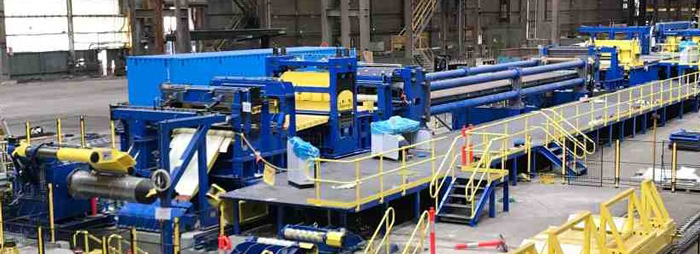ATHADER supplies Leveling CTL, revamps and levelers with the latest technologies depending on the application and the customers needs.
1. Roller Levelers – ATHADER
The purpose of the Athader multi-roll rollers is to produce a correctly flat strip and eliminate all flatness defects such as central buckle, wavy edges, longitudinal or transverse curvature. As well as equalizing the internal stresses to reduce “memory” and thus avoid the deformation of the sheets in subsequent processes, such as laser cutting.

Characteristics:
- 4 or 6 high, with roll diameters from 20 to 240 mm to cover all the ranges of thicknesses and qualities of materials on the market.
- Automatic regulation of the leveler, which is carried out by pre-setting and is displayed on the HMI of the main desk.
- Levelers with removable cassettes with rolls of different diameters for cut to length lines with a wide range of thicknesses. Dozens of cartridge levelers already in operation, some of them with up to 3 cassettes.
- The extraction and “book type” opening of cassettes are widely used in lines that process delicate materials, since it facilitates the cleaning of the cassette before changing the process.
2. e•Drive® hydraulic levelers – BRADBURY
With BRADBURY’s hydraulic levelers and e • Drive® patented technology, it is possible to go one step further in the leveling capacity and ease of use of the levelers. This leveler is available in 4, 5 and 6 high configurations.
- The patented e•Drive® Technology utilizes separate entry and exit motors. The entry motor powers the rolls within the “plunge” region of the leveler where yielding of the material occurs, reaching plastification. The second exit motor is employed with slightly greater torque enabling the material to be pulled toward the exit of the leveler. This pulling action provides concentrated tension and with a greater strip to roll contact angle to the strip at the point of plastification. Without strip tension, the material would bridle around the rolls with a neutral axis at its center, dividing areas of minimal compression and minimal tension. However, as the e•Drive® increases the tension, the neutral axis moves from the center toward the surface of the workroll significantly reducing the area of residual stress causing greater plastic deformation of the strip.
- The Bradbury e•Drive® Leveler is the first hydraulic roller leveler independently proven to penetrate the neutral axis of the strip for stress equalization through the cross-section of the material .
- Calibration – The control also features auto calibration. The transducers and operating system allow one button calibration after installation of the gauge plates. There is no need to individually adjust a transducer after the initial setup with the transducer gauge block
- Flat Trak® CL: The Bradbury Flat Trak® CL unit is designed to monitor, measure, and report the flatness of material produced by the leveler. FlatTrak® CL will monitor leveler output and alert the operator of any out of flatness dimension outside the established flatness tolerance range.
3. Stretch leveling – LEVELTEK
For this technology, Athader has partnered with LEVELTEK INTERNATIONAL, who designs, manufactures and installs stretch levelers.
Athader currently has several successful projects carried out in Australia and Europe, where the combination of LEVELTEK leveling technology together with Athader equipment has achieved the best leveling quality and productivity results.

- The stretching process to correct these defects is straightforward. The coil is unwound, stretched and cut to length or recoiled.
- The equipment removes defects by seamlessly restoring coils that would otherwise end up as scrap and includes a proprietary non-marking grip system.
- One of the advantages of this technology is to be able to use a single leveler or flattener for the entire range of thicknesses and materials to be leveled,.
- The grippers, which are patented by Leveltek, conform to the profile of the strip to achieve 100% full contact, evenly distributed across the entire width of the strip contact area. The entire cross section is stretched uniformly.



